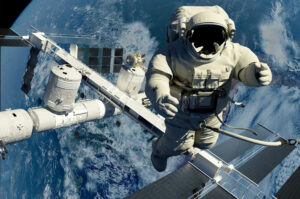In space, no one can hear you have a mental breakdown. The exploration of outer space brings with it not only fascinating scientific advancements but extreme situations and environments. These can be a real strain on the astronauts experiencing them. Away from the comforts of Earth, their home since birth, the time spent up there can take a real psychological toll.
Because of the psychological risks involved in sending people deeper into space, for longer periods of time, NASA has invested a lot of money and time into keeping space explorers sane. They even have a detailed set of written procedures for dealing with a suicidal or psychotic astronaut in space.
With a small group of people in an enclosed environment, feelings of isolation and claustrophobia could very reasonably occur. Astronauts may undergo difficulty sleeping, irritability, or feel discouraged in their work. All of which are a much greater cause for concern when the person experiencing them is thousands of miles away.
However, NASA’s got a plan for every eventuality.
Where it all started
 The idea of aerospace psychology dates back to Russian missions on board the Salyut 6 (1977 – 1982) and Salyut 7 (1982 – 1991) space stations. These missions saw cosmonauts staying on board the space stations for much longer periods than ever before. Salyut 6 was the first ever six-month space mission, and Salyut 7 the first eight-month one.
The idea of aerospace psychology dates back to Russian missions on board the Salyut 6 (1977 – 1982) and Salyut 7 (1982 – 1991) space stations. These missions saw cosmonauts staying on board the space stations for much longer periods than ever before. Salyut 6 was the first ever six-month space mission, and Salyut 7 the first eight-month one.
During these long missions, cosmonauts began showing noticeable signs of psychological distress. Think back to eight months ago and imagine that all this time you were in a spacecraft measuring 52 feet by 13 feet, with only one or two people to keep you company!
The Russians, therefore, saw the need to develop an aerospace psychology program to ensure that future missions wouldn’t put crew members in any jeopardy. They brought in psychological experts who helped at multiple stages – from initially selecting cosmonauts, all the way to providing support when they were in space.
NASA’s Psychological Support
In the mid-1990s NASA developed their behavioral health and support group for the astronauts on Russia’s Mir Space Station. Up until that point, the missions NASA’s astronauts had been on hadn’t been long enough to warrant the need for psychological support.
On this particular mission, the American astronauts had some difficulty in communicating with their Russian colleagues and found there was a lack of leisure activities available on Mir. Some even acknowledged the difficulties of living in such conditions for long periods of time publicly.
With isolation at the root of many psychological issues such as anxiety and depression, it’s clear how these could quickly manifest themselves in astronauts on long missions.
Selecting Astronauts
 Nowadays, the candidate selection process at NASA lays out 9 “suitability proficiencies” from the start. This ensures that only candidates who possess the strongest minds are selected. These criteria include group living skills; self-regulation of one’s emotion and mood; and judgment and decision-making skills.
Nowadays, the candidate selection process at NASA lays out 9 “suitability proficiencies” from the start. This ensures that only candidates who possess the strongest minds are selected. These criteria include group living skills; self-regulation of one’s emotion and mood; and judgment and decision-making skills.
Often, the selection process actively looks for candidates in roles that already require high levels of mental capability, such as dealing with stress. In addition to this, astronauts are often screened for compatibility among space crews.
Preparation
Astronauts are informed two years before a mission that they will be heading into space. This gives them plenty of time to prepare mentally for the mission. During this run-up period, the psychological experts deliver what they call “behavioral medicine.” They meet with the astronauts regularly in the lead-up to the launch, as well as providing training so the astronauts can identify psychological deterioration in crew-members.
In Space
Once in space, they speak with the psychologists every two weeks via video-link. Typically they will cover everything from how they are sleeping to their morale and workload. The psychologists note astronauts perform exceptionally well for 95 percent of a mission’s duration, only occasionally dipping to mundane frustrations. Nothing that could terminate a mission, though!
The psychologists also ensure that astronauts have access to their favorite hobbies and entertainment – even Game of Thrones – for their essential leisure and de-stress time. Imagine living in your office 24/7 for six months or more – your downtime needs to be of the highest quality!
Back at Home
NASA’s psychologists will even work with ground-based crew members during missions. Once those who left the stratosphere return, they go through three more assessments covering lessons learned, as well as adjusting to life back on Earth.
The Future of Aerospace Psychology?
 With commercial space travel, as well as longer space missions on the cards, aerospace psychology will have to adapt quickly. One such idea is to use artificial intelligence programs on board the spacecraft for astronauts to speak to.
With commercial space travel, as well as longer space missions on the cards, aerospace psychology will have to adapt quickly. One such idea is to use artificial intelligence programs on board the spacecraft for astronauts to speak to.
The delay in communications between Earth and a base on Mars would be around 45 minutes. Not ideal if someone were to have a breakdown! They would need immediate assistance and guidance, and AI technology could provide such instant cognitive behavioral therapy.
As astronauts push boundaries year on year, it can be easy to forget that under their spacesuit, they’re human beings. They have families that they’ll miss, home comforts that they’ll crave, and will have to cope with huge stress on their missions. Technology is advancing at an incredible rate, but at the end of it all, we’re all just humans finding our place in this universe, and sometimes we need a little therapy to keep us grounded.
Sources:
http://www.nasa.gov/audience/forstudents/5-8/features/nasa-knows/what-is-nasa-58.html
https://www.inverse.com/article/19326-space-psychology-nasa-astronauts-mental-health-mars
http://gizmodo.com/salyut-7-the-last-and-longest-running-soviet-space-sta-1640462206
http://www.seeker.com/why-space-madness-fears-haunted-nasas-past-1765739692.html

